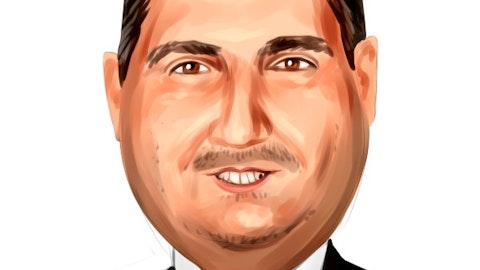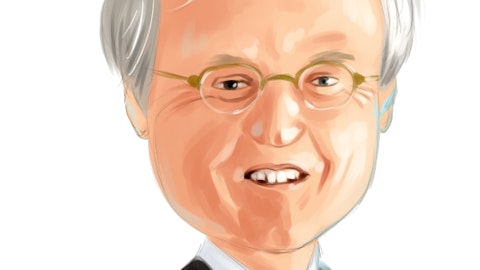Universal Health Services, Inc. (NYSE:UHS) Q4 2022 Earnings Call Transcript February 28, 2023
Steve Filton: I’m Steve Filton. Marc Miller is joining us this morning. Welcome to this review of Universal Health Services results for the Fourth Quarter Ended December 31, 2022. During the conference call, we’ll be using words such as believes, expects, anticipates, estimates and similar words that represent forecasts, projections and forward-looking statements. For anyone not familiar with the risks and uncertainties inherent in these forward-looking statements, I recommend a careful reading of the section on risk factors and forward-looking statements and risk factors in our Form 10-K for the year ended December 31, 2022. We’d like to highlight just a couple of developments and business trends before opening the call up to questions.
As discussed in our press release last night, the company reported net income attributable to UHS per diluted share of $2.43 for the fourth quarter of 2022. After adjusting for the impact of the items reflected on the supplemental schedule, as included with the press release, primarily an asset impairment charge associated with an acute care hospital in Las Vegas, our adjusted net income attributable to UHS per diluted share was $3.02 for the quarter ended December 31, 2022.
Marc Miller: During the fourth quarter, our acute care hospitals experienced a decrease in the number of patients with a COVID diagnosis treated in our hospitals as compared to the prior year quarter. As a percentage of total admissions, COVID diagnosed patients made up 7% of our admissions in the fourth quarter of 2021, but only about half of that percentage of admissions in the fourth quarter of 2022. This decline in COVID patients resulted in reduced revenues due to the lower acuity and less of the incremental government reimbursement associated with COVID patients. While overall surgical volumes tended to recover to pre-pandemic levels, there was a measurable shift from inpatient to outpatient, resulting in further overall revenue softness.
Meanwhile, the amount of premium pay in the quarter, which declined from a peak of $153 million in the first quarter was $85 million in the fourth quarter, similar to what it was in the third quarter. In total, there was insufficient revenue growth to offset the accelerated rate of wage increases and other inflationary pressures, leading to an acute EBITDA result in the quarter below our internal forecasts. At the same time, this decline in COVID activity allowed our behavioral hospitals to continue to reduce their labor vacancies, resulting in a reduction of the capping of bed capacity. The effect of the increased revenue largely offset higher labor costs, leading to a behavioral EBITDA result in the quarter more in line with our internal forecasts.
Steve Filton: We also note that the fourth quarter included approximately $10 million of losses related to start-up facilities. Our cash generated from operating activities was $297 million during the fourth quarter of 2022 as compared to $322 million during the same quarter in 2021. The decline was largely due to the opening of new facilities and the timing of receipt of certain supplemental reimbursements. We spent $734 million on capital expenditures during 2022. Reaction to the earnings softness experienced during the year, we reduced the pace of our capital expenditure spend by about one quarter from our original plans for the year. Similarly, we moderated the trajectory of our share repurchases. For the full year of 2022, we acquired $811 million of our own shares pursuant to our share repurchase program.
Since the inception of the current share repurchase program in 2014, we have repurchased more than 20% of the company’s outstanding shares. As of December 31, 2022, we had $886 million of aggregate available borrowing capacity pursuant to our $1.2 billion revolving credit facility.
Marc Miller: Our 2023 operating results forecast, which was provided in last night’s release, Envision’s 2023 as a year of continued transition into a post-pandemic world. We anticipate that volumes in both segments and acuity in our acute business will continue their recovery trajectory and gradually begin to resemble the patterns we experienced before the pandemic. Similarly, we expect to be able to reduce premium pay by about one-third in 2023 from 2022 levels as we continue to increase hiring rates and reduce turnover as a result of multiple recruitment and retention programs that have been implemented over the last few years. Again, we’ve assumed these improvements will occur incrementally during the year. But will be partially offset by wage pressures created by a continued shortage of nurses and other clinical personnel and by broader inflationary pressures affecting our other expenses.
We note that in our Acute segment, physician subsidy expense is specifically anticipated to increase by a substantial amount. Other headwinds that are reflected in our 2023 forecast are approximately $100 million in COVID-related reimbursement received in 2022, but phased out in 2023 as well as a reduction of about $30 million in supplemental reimbursement payments as disclosed in our 10-K. Finally, we will incur a significant increase in interest expense in 2023. About three quarters of which was due to rising interest rates and the remainder to increased borrowings. Despite these challenges, we note that some of the operating indicators in early 2023 have been encouraging, especially in our behavioral health business. During the pandemic, we have found the pace of recovery from several of the aforementioned challenges has often been slower than we originally anticipated and have reflected that gradual cadence of recovery in our forecast.
However, we remain confident in the fundamental strength of both our business segments, given our well-positioned hospital franchises around the country. We are pleased to answer questions at this time.
Operator: Thank you. Our first call comes from the line of Andrew Mok with UBS. Your line is now open.
See also 30 Largest Trading Partners of the US and 25 Countries with the Lowest Corporate Tax Rates.
Q&A Session
Follow Universal Health Services Inc (NYSE:UHS)
Follow Universal Health Services Inc (NYSE:UHS)
Andrew Mok: Hi good morning. You mentioned softer revenue in the Acute segment due to lower acuity. Can you elaborate on the trends in surgical volumes and underlying acuity that you saw in the fourth quarter? And what do you have embedded in the guide for 2023? Or when do you expect that to normalize? Thanks.
Steve Filton: Yes, Andrew. So, I think as Marc remarked in his commentary, and you can see in our press release metrics, revenue per adjusted admission was actually down for the quarter. I think attributable to a few factors. One is the decline in COVID patients, those COVID patients, particularly last year, particularly the Omicron patients tended to be higher acuity patients and the loss of those patients and the loss of their good reimbursement reduces our acuity in our revenue. In addition to that, Marc talked about the shift, the accelerated shift from inpatient to outpatient. Our surgical volumes in Q4 actually, we’re probably 3% or 4% above what they were in Q4 of 2019, the last pre-pandemic quarter, full pre-pandemic quarter, but clearly, there’s been an accelerated shift.
I think that outpatient procedures are probably up 7% or 8% and inpatient procedures are sort of flattish. So, I think those are the main drivers of the acuity softness in Q4. As far as what we have built into the guidance for next year, I think, again, as Marc sort of comments reflected, I think we’re projecting a gradual sort of return to normalcy. So for the year, I think our general notion is that acute care revenue per adjusted admission should increase probably in that 2% to 4% range, which would be much closer to sort of the historical norms.
Operator: Our next call comes from the line of Stephen Baxter with Wells Fargo.
Stephen Baxter: least directionally by segment. Appreciating the color you gave on some of the onetime items in the acute care business. It sounds like that’s likely the source of maybe some of the year-on-year pressure there, but it’d be great if you could elaborate a little bit on what you’re expecting for year-over-year margin trends in both the acute and the behavioral business? Thanks.
Steve Filton: Yes, Steve, I think we missed the beginning part of your question somehow. So if you wouldn’t mind repeating it, I apologize.
Stephen Baxter: Yes. Sorry about that. So yes, the additional color on EBITDA growth and top-line growth by segment would be great. Just trying to understand a little bit when we look at the year-over-year margin pressure, where that’s coming from? It sounds like with some of the items you flagged on the acute side, it looks like that’s probably it, but just a better sense on the direction of margin trends in both businesses. Thanks.
Steve Filton: Yes. So, I think on the acute side, there are specific headwinds, again, most of which I think Marc elaborate on, one and probably the biggest one is $100 million of COVID-related reimbursement that includes the Medicare 20% add-on, the Hertz reimbursement and Medicare sequestration waver all of which get phased out at one point or another already phased out in 2023. I’ll throw into that, although not COVID related, another $10 million or so of 340B reimbursement that’s going to get recouped in 2023. In addition to that, there’s Marc noted about $30 million of supplemental Medicaid reimbursement that declines next year. That’s about $20 million in the behavioral business and $10 million in the acute business.
I think the other main issue is that even though, again, as Marc commented, we’re expecting premium pay to decline another one-third, maybe another $150 million, $160 million in 2023, what our experience has been is that the savings from that, and there certainly are some savings, but the savings from that are offset to a large degree by increased base wages, recruitment incentives, sign-on bonuses, that sort of thing. I think what our guidance, particularly in the acute business implies or assumes is that all those trends sort of incrementally improve as the year goes on. But those are the headwinds, I think, specifically on the acute side of the business that mainly sort of tend to suppress the margins. And on the behavioral side, it’s really more on the labor side.




